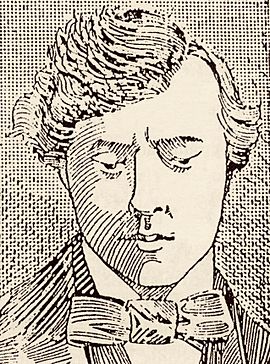Francis Webb Sheilds facts for kids
Francis Webb Wentworth-Sheilds was an important engineer from Ireland. He was born on October 8, 1820, and passed away on January 18, 1906. He is best known for his work on the Sydney Railway Company in Australia. He helped build the railway before it even opened.
He worked on many railway projects in Great Britain and Ireland. This included the Dublin and Kingstown Railway. He truly believed he was born to be a railway engineer!
Contents
Working as Sydney's City Surveyor
Francis Sheilds also worked as the City Surveyor for Sydney, Australia. He held this job for a few years starting in 1843. During this time, he helped with important water projects for the city.
He decided to leave this role in 1849. He wanted to take on a new challenge with the Sydney Railway Company.
Engineering for the Sydney Railway Company
Sheilds is mostly remembered for a big decision he made about railway tracks. He convinced the Sydney Railway Company to use a specific size for their tracks. This size is called the Irish gauge, which is 5 ft 3 in (1,600 mm) wide. This was different from the English standard gauge, which is 4 ft 8 1⁄2 in (1,435 mm).
Sheilds had worked on railways in Ireland. Ireland had already chosen the Irish gauge as its standard. The British Board of Trade supported his idea. All Australian colonies agreed to use this gauge at first.
The Gauge Change Problem
Sheilds left the company in 1850. His pay was cut because the company was having money problems. His replacement, a Scotsman named James Wallace, suggested a change. He recommended that the track size should be the English standard gauge of 4 ft 8 1⁄2 in (1,435 mm). The government of New South Wales agreed with this new plan.
However, building of the 5 ft 3 in (1,600 mm) broad gauge lines had already started. This was happening in Victoria and South Australia. The trains and equipment needed for these wider tracks had already been ordered. Victoria and South Australia strongly protested this change. They refused to switch their plans.
The Impact of Different Track Sizes
Sheilds's first recommendation, and then New South Wales changing its mind, caused a big problem. This is the reason for the "breaks of gauge" in Australia. A break of gauge happens when trains have to switch tracks because the track sizes are different. This means trains cannot travel directly from one state to another without stopping.
To make things even more complicated, most other Australian colonies later chose an even cheaper, narrower track size. This was the 3 ft 6 in (1,067 mm) gauge. Tasmania's first railway used the Irish gauge, as originally agreed. But it was later changed to the 3 ft 6 in (1,067 mm) gauge in 1888.
See also
- Rail gauge in Australia


